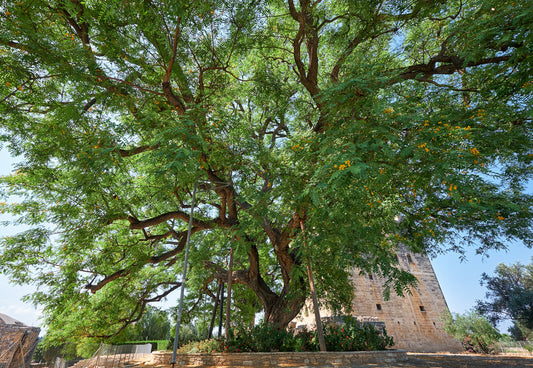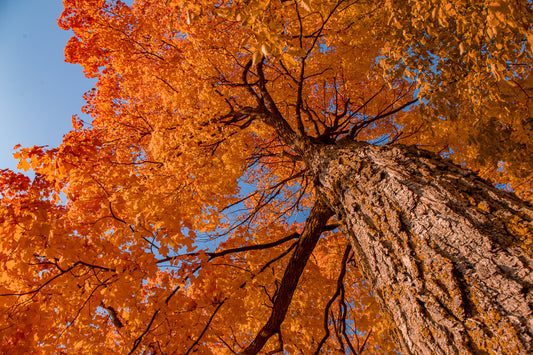The Oak Forest
One of the most tangible roles of oaks is as a food source. Their acorns, packed with energy-rich fats and carbohydrates, serve as nourishment for a multitude of wildlife. Squirrels, for example, rely heavily on acorns for their diet, often stowing away excess for leaner times, a behavior that also assists in the dispersal and germination of new oak trees. Deer and other large mammals are also attracted to these nutritious nuts, contributing to the food chain's diversity and stability.

Photo of oak trees creating a canopy over a patio in Lebanon
The structure of the oak tree creates a dynamic ecosystem within itself, offering a home and refuge to a myriad of species. Birds such as the Great Spotted Woodpecker and the Tawny Owl in Europe, or the Red-Headed Woodpecker and Eastern Screech Owl in North America, use them for nesting and perching. Insects like bark beetles, including the Red Oak Borer, burrow into the tree's bark for laying their eggs, while various moth species such as the Purple Hairstreak Moth rely on the oak tree for their life cycle. Even larger mammals, like the North American Black Bear, have been known to utilize oak trees for shelter and as a vantage point for cubs.
Below ground, oak trees engage in an extraordinary partnership with a type of fungi known as mycorrhizal fungi, creating a network nicknamed the "wood wide web." These fungi function as an extension of the root system, helping the tree absorb essential nutrients and water from the soil. In exchange, the tree supplies the fungi with sugars and other organic compounds it produces through photosynthesis.
This network allows trees to exchange nutrients, helping the ones struggling to survive, and even send chemical signals to each other, most famously distress signals about environmental threats. For instance, if one tree is under attack from insects, it can pass on chemical warnings through the network, prompting nearby trees to boost their defenses.
Also thanks to their extensive root systems, oak trees serve as a robust defense against erosion, a significant issue in these often damp and hilly environments. The roots bind the soil, reducing the risk of landslides and soil wash-off during heavy rainfall, thus stabilizing the landscape for nature and human benefit alike.
Their massive canopies shape the forest's microclimate. By their sheer size and leaf density, they moderate temperature extremes, absorbing the sun's heat during the day and retaining warmth during cooler nights. This effect helps to maintain a relatively stable and comfortable climate for the forest's inhabitants.
The canopy is also instrumental in regulating the forest's water cycle. It intercepts heavy rainfall, tempering its direct impact on the soil and slowly releasing it back into the environment in the form of mist, dew, or through stemflow down their trunks. Simultaneously, during droughts, this dense cover becomes essential for moisture conservation, casting a protective shade that reduces evaporation and helps retain water.
The shade provided by the vast oak canopies also contributes significantly to creating a hospitable habitat for a wide range of flora and fauna. The filtered sunlight that penetrates through the leaves creates a range of light conditions beneath, supporting the growth of a variety of understory plants.

Threats and challenges
The resilience and strength of oak trees are now being tested as they face a host of threats in the modern world. These threats arise from various sources including environmental changes, pest and disease outbreaks, and most significantly, human activities such as deforestation and unsustainable harvesting practices.
Environmental challenges are an escalating concern. Climate change puts unprecedented strain on their capacity to adapt to shifting temperature and precipitation patterns. Invasive species, such as the Oak Processionary Moth in Europe, and diseases such as Oak Wilt in the US or Acute Oak Decline in the UK, are already having devastating effects.
On top of these environmental challenges, a significant concern for oak trees worldwide is deforestation. With their long lifespan and durable wood, oak trees are prime targets for the logging industry. Even though certain logging practices can be managed sustainably, the reality is that the world's demand for timber and other wood products often leads to extensive and rapid deforestation. This process is not just the simple removal of trees—it's the destruction of complex, thriving ecosystems.
Deforestation disrupts the complex array of ecological services that benefit both the forest communities and humanity itself. These range from providing a habitat for myriad species, contributing to nutrient cycles, and acting as an essential carbon sink, to anchoring the landscape to prevent soil erosion and landslides, filtering air pollutants, and regulating water cycles by intercepting rainfall and reducing runoff. Despite all these benefits, almost one in three of the world's oak species are threatened with extinction, according to The Red List of Oaks 2020, a report compiled by The Morton Arboretum and the IUCN’s Global Tree Specialist Group.
Despite the claims of sustainable harvesting by many timber companies, the reality is far bleaker. These firms often highlight their replanting efforts, but overlook the ecological impact of creating monoculture forests, which are single-species tree farms rather than diverse ecological communities. While such plantations may seem to be a picture of health and vitality, they lack the ecological richness and varied interplay of species that underpin the health and resilience of old-growth forests. These plantations, compared to their natural counterparts, are ecological deserts.
The future of oak
The future of oak trees hinges on our appreciation and sustainable utilization of this valuable resource. It's crucial to embrace responsible forestry practices, such as repurposing fallen lumber and offcuts for furniture production, which not only curbs waste but optimizes the use of existing resources and mitigates further tree cutting. Given oak's exceptional durability, we should perceive oak furniture not as a fleeting commodity but a lasting investment.
Taking meticulous care of oak furniture—repairing, refurbishing, and extending its lifespan—can diminish the demand for new resources while fostering a deeper respect for the material's ecological origin. Each piece of oak furniture embodies the narrative of a potentially centuries-old tree, and by caring for it, we honor that narrative and the ecosystems oak trees bolster.
Ultimately, sustainable practices in forestry, woodworking, and furniture care, along with a deep-seated respect for these trees and their ecological significance, are pivotal for the continued survival of oaks in our forests and our homes.
Article by: Andrei Mihail, see more about the author here




